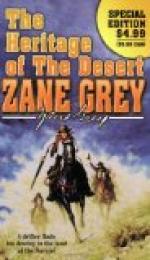How they would be able to climb the face of that steep cliff puzzled Hare. Upon nearer view he discovered the yard-wide trail curving upward in cork-screw fashion round a projecting corner of cliff. The stone was a soft red shale, and the trail had been cut in it at a steep angle. It was so steep that the burros appeared to be climbing straight up. Noddle pattered into it, dropped his head and his long ears and slackened his pace to patient plodding. August walked in the rear.
The first thing that struck Hare was the way the burros in front of him stopped at the curves in the trail, and turned in a space so small that their four feet were close together; yet as they swung their packs they scarcely scraped the wall. At every turn they were higher than he was, going in the opposite direction, yet he could reach out and touch them. He glanced up to see Mescal right above him, leaning forward with her brown hands clasping the pommel. Then he looked out and down; already the green cluster of cottonwoods lay far below. After that sensations pressed upon him. Round and round, up and up, steadily, surely, the beautiful mustang led the train; there were sounds of rattling stones, and click of hoofs, and scrape of pack. On one side towered the iron-stained cliff, not smooth or glistening at close range, but of dull, dead, rotting rock. The trail changed to a zigzag along a seamed and cracked buttress where ledges leaned outward waiting to fall. Then a steeper incline, where the burros crept upward warily, led to a level ledge heading to the left.
Mescal halted on a promontory. She, with her windblown hair, the gleam of white band about her head, and a dash of red along the fringed leggings, gave inexpressible life and beauty to that wild, jagged point of rock, sharp against the glaring sky.
“This is Lookout Point,” said Naab. “I keep an Indian here all the time during daylight. He’s a peon, a Navajo slave. He can’t talk, as he was born without a tongue, or it was cut out, but he has the best eyes of any Indian I know. You see this point commands the farm, the crossing, the Navajo Trail over the river, the Echo Cliffs opposite, where the Navajos signal to me, and also the White Sage Trail.”
The oasis shone under the triangular promontory; the river with its rising roar wound in bold curve from the split in the cliffs. To the right white-sloped Coconina breasted the horizon. Forward across the Canyon line opened the many-hued desert.
“With this peon watching here I’m not likely to be surprised,” said Naab. “That strip of sand protects me at night from approach, and I’ve never had anything to fear from across the river.”
Naab’s peon came from a little cave in the wall; and grinned the greeting he could not speak. To Hare’s uneducated eye all Indians resembled each other. Yet this one stood apart from the others, not differing in blanketed leanness, or straggling black hair, or bronze skin, but in the bird-of-prey cast of his features and the wildness of his glittering eyes. Naab gave him a bag from one of the packs, spoke a few words in Navajo, and then slapped the burros into the trail.




